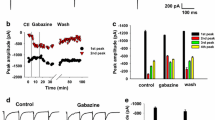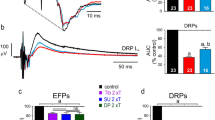Summary
When ejected microelectrophoretically near spinal interneurones of cats anaesthetised with pentobarbitone and under conditions where postsynaptic excitability was maintained artificially at a constant level, (−), but not (+), -baclofen selectively reduced monosynaptic excitation by impulses in low threshold muscle (Ia and Ib) and cutaneous (Aα) afferents. Polysynaptic excitation of interneurones and Renshaw cells by impulses in higher threshold afferents was less affected, and baclofen had little or no effect on the cholinergic monosynaptic excitation of Renshaw cells. Glycinergic and gabergic inhibitions of spinal neurones were relatively insensitive to baclofen. These stereospecific actions of baclofen, produced by either a reduction in the release of excitatory transmitter or postsynaptic antagonism, suggest that Ia, Ib, and Aα afferents may release the same excitatory transmitter which differs from that of spinal excitatory interneurones.
Microelectrophoretic (−), but not (+), -baclofen also reduced primary afferent depolarization of ventral horn Ia extensor afferent terminations produced by impulses in low threshold flexor afferents, without altering either the electrical excitability of the terminations or their depolarization by electrophoretic GABA or L-glutamate. This stereospecific action of baclofen is interpreted as a reduction in the release of GABA at depolarizing axo-axonic synapses on Ia terminals.
Similar content being viewed by others
References
Ault B, Evans RH (1978) Central depressant action of baclofen. J Physiol 284: 131P
Barber R, Saito K (1976) Light-microscopic visualization of GAD and GABA-T in immunocytochemical preparations of rodent CNS. In: Roberts E, Chase TN, Tower DB (eds) GABA in nervous system function. Raven Press, New York, pp 113–132
Beart PM, Johnston GAR (1973) GABA uptake in rat brain slices: Inhibition by GABA analogues and by various drugs. J Neurochem 20: 319–324
Bein H (1972) Pharmacological differentiation of muscle relaxants. In: Birkmayer W (ed) Spasticity — a topical survey. Huber, Berne, pp 76–82
Cotman CW, Hamberger A (1978) Glutamate as a CNS neuro-transmitter: properties of release, inactivation, and biosynthesis. In: Fonnum F (ed) Amino acids as chemical transmitters. Plenum Press, New York, pp 379–412
Curtis DR (1979a) Problems in the evaluation of glutamate as a central nervous system transmitter. In: Filer LJ, Jr, Garattini S, Kare MR, Reynolds WA, Wurtman RH (eds) Glutamic acid: Advances in biochemistry and physiology. Raven Press, New York, pp 163–175
Curtis DR (1979b) A method for continuously monitoring the electrical threshold of single intraspinal nerve fibres. Electroencephalogr Clin Neurophysiol 47: 503–506
Curtis DR, Game CJA, Johnston GAR, McCulloch RM (1974) Central effects of β-(p-chlorophenyl)-γ-aminobutyric acid. Brain Res 70: 493–499
Curtis DR, Lodge D (1978) GABA depolarization of spinal group I afferent terminals. In: Ryall RW, Kelly JS (eds) Iontophoresis and transmitter mechanisms in the mammalian central nervous system. Elsevier/North-Holland Biomedical Press, Amsterdam New York, pp 258–260
Curtis DR, Lodge D, Headley PM (1979) Electrical interaction between motoneurons and afferent terminals in cat spinal cord. J Neurophysiol 42: 635–641
Davidoff RA (1978) Pharmacology of spasticity. Neurology (Minneap) 28: 46–51
Davidoff RA, Sears ES (1974) The effects of Lioresal on synaptic activity in the isolated spinal cord. Neurology (Minneap) 24: 957–963
Davies J, Watkins JC (1974) The action of β-phenyl-GABA derivatives on neurones of the cat cerebral cortex. Brain Res 70: 501–505
Deschenes M, Feltz P, Lamour Y (1976) A model for an estimate in vivo of the ionic basis of presynaptic inhibition: An intracellular analysis of the GABA-induced depolarization in rat dorsal root ganglia. Brain Res 118: 486–493
Eccles JC, Eccles RM, Lundberg A (1960) Types of neurone in and around the intermediate nucleus of the lumbosacral cord. J Physiol 154: 89–114
Eccles JC, Fatt P, Koketsu K (1954) Cholinergic and inhibitory synapses in a pathway from motor-axon collaterals to motoneurones. J Physiol 126: 524–562
Eccles JC, Fatt P, Landgren S (1956) Central pathway for direct inhibitory action of impulses in largest afferent nerve fibres to muscle. J Neurophysiol 19: 75–98
Emson PC (1979) Peptides as neurotransmitter candidates in mammalian CNS. Prog Neurobiol 13: 61–116
Engberg I, Marshall KC (1979) Reversal potential for Ia excitatory post synaptic potentials in spinal motoneurones of cats. Neuroscience 4: 1583–1591
Faigle JW, Keberle H (1972) The metabolism and pharmacokinetics of Lioresal. In: Birkmayer W (ed) Spasticity — a topical survey. Huber, Berne, pp 94–100
Feldman RG, Young RR, Koella, WP (1980) Spasticity: Disordered motor control. Symposia Specialists, Miami
Flatman JA, Lambert JDC (1979) The use of intracellular QX222 as a tool in neurophysiological experiments on cat spinal motoneurones. J Physiol 295: 7–8P
Fox S, Krnjević K, Morris ME, Puil E, Werman R (1978) Action of baclofen on mammalian synaptic transmission. Neuroscience 3: 495–515
Fukuda H, Kudo Y, Ono H (1977) Effects of β-(p-chlorophenyl)-GABA (baclofen) on spinal synaptic activity. Eur J Pharmacol 44: 17–24
Gallagher JP, Higashi H, Nishi S (1978) Characterization and ionic basis of GABA-induced depolarization recorded in vitro from cat primary afferent neurones. J Physiol 275: 263–282
Gregor M, Zimmermann M (1972) Characteristics of spinal neurones responding to cutaneous myelinated and unmyelinated fibres. J Physiol 221: 555–576
Haase J, Cleveland S, Ross H-G (1975) Problems of postsynaptic autogenous and recurrent inhibition in the mammalian spinal cord. Rev Physiol Biochem Pharmacol 73: 73–129
Henry JL (1979) l-Baclofen preferentially depresses nociceptive inputs in lumbar dorsal horn in the cat. Soc Neurosci Abst 5: 610
Henry JL, Ben-Ari Y (1976) Actions of the p-chlorophenyl derivative of GABA, lioresal, on nociceptive and non-nociceptive units in the spinal cord of the cat. Brain Res 117: 540–544
Hicks TP, McLennan H (1979) Amino acids and the synaptic pharmacology of granule cells in the dentate gyrus of the rat. Can J Physiol Pharmacol 57: 973–978
Hultborn H, Jankowska E, Lindström S (1971) Recurrent inhibition of interneurones monosynaptically activated from group Ia afferents. J Physiol 215: 613–656
Johnston GAR, Hailstone MH, Freeman CG (1980) Baclofen: stereoselective inhibition of excitant amino release. J Pharm Pharmacol 32: 230–231
Kato M, Waldmann U, Murakami S (1978) Effects of baclofen on spinal neurones of cats. Neuropharmacology 17: 827–833
Knutsson E, Lindblom U, Martensson A (1974) Plasma and cerebrospinal fluid levels of baclofen (Lioresal) at optimal therapeutic responses in spastic paresis. J Neurol Sci 23: 473–484
Krnjević K, Lamour Y, MacDonald JF, Nistri A (1979) Depression of monosynaptic excitatory postsynaptic potentials by Mn2+ and Co2+ in cat spinal cord. Neuroscience 4: 1331–1339
Lodge D, Curtis DR, Brand SJ (1977) A pharmacological study of the inhibition of ventral group Ia-excited spinal inter-neurones. Exp Brain Res 29: 97–105
McLaughlin BJ, Barber R, Saito K, Roberts E, Wu JY (1975) Immunocytochemical localization of glutamate decarboxylase in rat spinal cord. J Comp Neurol 164: 305–322
Munson JB, Sypert GW (1979) Properties of single fibre excitatory post-synaptic potentials in triceps surae motoneurones. J Physiol 296: 329–342
Nistri A (1975) Further investigations into the effects of baclofen (Lioresal) on the isolated spinal cord. Experientia 31: 1066–1068
Olpe H-R, Demieville H, Baltzer V, Bencze WL, Koella WP, Wolf P, Haas HL (1978) The biological activity of d- and l-baclofen (Lioresal). Eur J Pharmacol 52: 133–136
Olpe H-R, Koella WP, Wolf P, Haas HL (1977) The action of baclofen on neurons of the substantia nigra and of the ventral tegmental area. Brain Res 134: 577–580
Ono H, Fukuda H, Kudo Y (1979) Mechanisms of depressant action of baclofen on the spinal reflex in the rat. Neuropharmacology 18: 647–653
Otsuka M, Konishi S (1976) GABA in the spinal cord. In: Roberts E, Chase TN, Tower DB (eds) GABA in nervous system function. Raven Press, New York, pp 197–202
Pierau F-K, Matheson GK, Wurster RD (1975) Presynaptic action of β(4-chlorophenyl)-GABA. Exp Neurol 48: 343–351
Pierau F-K, Zimmermann P (1973) Action of a GABA-derivative on postsynaptic potentials and membrane properties of cats' spinal motoneurones. Brain Res 54: 376–380
Piercey MF, Hollister RP (1979) Effects of intravenous baclofen on dorsal horn neurons of spinal cats. Eur J Pharmacol 53: 379–382
Polc P, Haefely W (1976a) Effects of two benzodiazepines, phenobarbitone, and baclofen on synaptic transmission in the cat cuneate nucleus. Naunyn Schmiedeberg's Arch Pharmacol 294: 121–131
Polc P, Haefely W (1976b) Is baclofen an antagonist of the excitatory transmitter in the cat cuneate nucleus? Experientia 32: 781–782
Potashner SJ (1978) Baclofen: effects on amino acid release. Can J Physiol Parmacol 56: 150–154
Redman S (1979) Junctional mechanisms at group Ia synapses. Prog Neurobiol 12: 33–83
Reinhardt W, Ben-Ari Y (1979) Baclofen does not block the synaptic action of the perforant path on hippocampal cells. Soc Neurosci Abst 5: 281
Saito K, Konishi S, Otsuka M (1975) Antagonism between Lioresal and substance P in rat spinal cord. Brain Res 97: 177–180
Wilson PR, Yaksh TL (1978) Baclofen is antinociceptive in the spinal intrathecal space of animals. Eur J Pharmacol 51: 323–330
Author information
Authors and Affiliations
Rights and permissions
About this article
Cite this article
Curtis, D.R., Lodge, D., Bornstein, J.C. et al. Selective effects of (−)-baclofen on spinal synaptic transmission in the cat. Exp Brain Res 42, 158–170 (1981). https://doi.org/10.1007/BF00236902
Received:
Issue Date:
DOI: https://doi.org/10.1007/BF00236902




